Financial Accounting Assignment: Concepts and Principles
VerifiedAdded on 2023/06/04
|8
|1282
|94
Homework Assignment
AI Summary
This document provides a comprehensive solution to a financial accounting assignment, addressing key concepts and principles. Part A includes an Excel file while Part B delves into the conceptual framework, explaining its role in financial reporting and its various components. The assignment clarifies the objectives of financial reporting, emphasizing the importance of providing valuable and understandable information to users. It also explores Generally Accepted Accounting Principles (GAAP) and their characteristics, ensuring consistency and comparability in financial statements. Furthermore, the document outlines the qualitative characteristics of financial reporting, such as relevance, timeliness, and faithful representation. Finally, it discusses the basic accounting assumptions, including business entity, going concern, accounting period, and money measurement assumptions. This document is a valuable resource for students seeking to understand and excel in financial accounting.
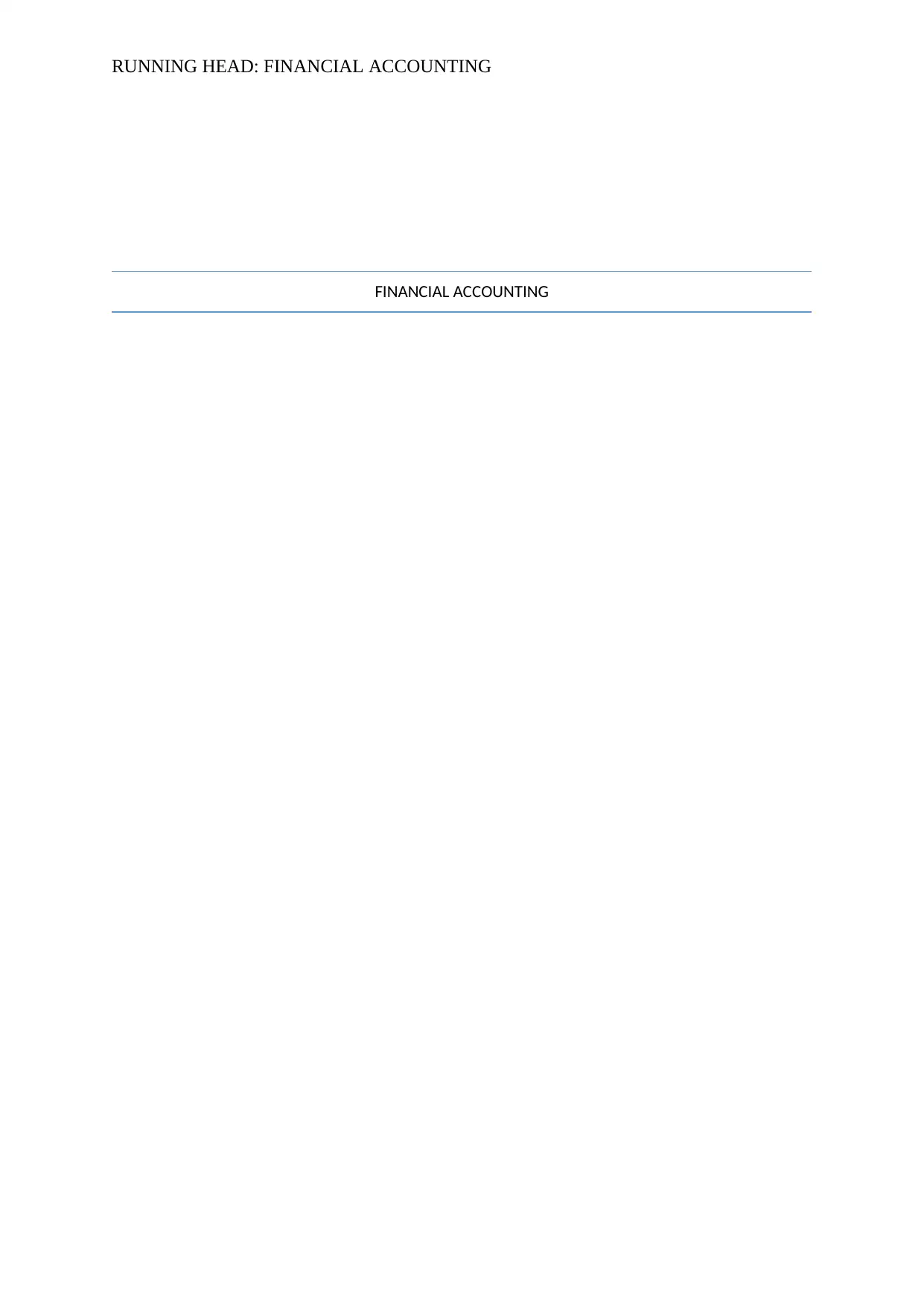
RUNNING HEAD: FINANCIAL ACCOUNTING
FINANCIAL ACCOUNTING
FINANCIAL ACCOUNTING
Paraphrase This Document
Need a fresh take? Get an instant paraphrase of this document with our AI Paraphraser

FINANCIAL REPORTING 1
Contents
PART A...................................................................................................................................................2
PART B...................................................................................................................................................2
REFERENCES..........................................................................................................................................7
Contents
PART A...................................................................................................................................................2
PART B...................................................................................................................................................2
REFERENCES..........................................................................................................................................7
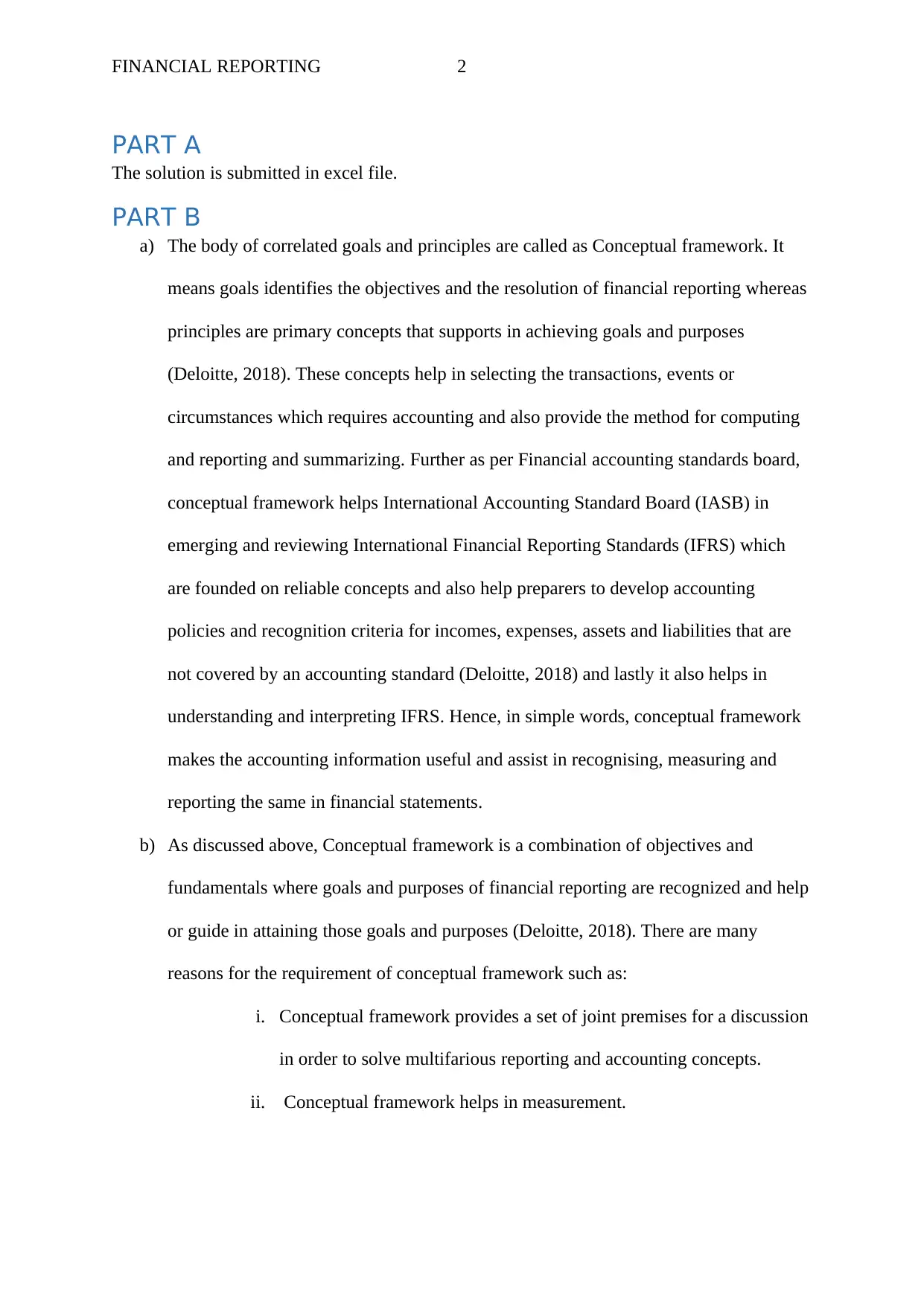
FINANCIAL REPORTING 2
PART A
The solution is submitted in excel file.
PART B
a) The body of correlated goals and principles are called as Conceptual framework. It
means goals identifies the objectives and the resolution of financial reporting whereas
principles are primary concepts that supports in achieving goals and purposes
(Deloitte, 2018). These concepts help in selecting the transactions, events or
circumstances which requires accounting and also provide the method for computing
and reporting and summarizing. Further as per Financial accounting standards board,
conceptual framework helps International Accounting Standard Board (IASB) in
emerging and reviewing International Financial Reporting Standards (IFRS) which
are founded on reliable concepts and also help preparers to develop accounting
policies and recognition criteria for incomes, expenses, assets and liabilities that are
not covered by an accounting standard (Deloitte, 2018) and lastly it also helps in
understanding and interpreting IFRS. Hence, in simple words, conceptual framework
makes the accounting information useful and assist in recognising, measuring and
reporting the same in financial statements.
b) As discussed above, Conceptual framework is a combination of objectives and
fundamentals where goals and purposes of financial reporting are recognized and help
or guide in attaining those goals and purposes (Deloitte, 2018). There are many
reasons for the requirement of conceptual framework such as:
i. Conceptual framework provides a set of joint premises for a discussion
in order to solve multifarious reporting and accounting concepts.
ii. Conceptual framework helps in measurement.
PART A
The solution is submitted in excel file.
PART B
a) The body of correlated goals and principles are called as Conceptual framework. It
means goals identifies the objectives and the resolution of financial reporting whereas
principles are primary concepts that supports in achieving goals and purposes
(Deloitte, 2018). These concepts help in selecting the transactions, events or
circumstances which requires accounting and also provide the method for computing
and reporting and summarizing. Further as per Financial accounting standards board,
conceptual framework helps International Accounting Standard Board (IASB) in
emerging and reviewing International Financial Reporting Standards (IFRS) which
are founded on reliable concepts and also help preparers to develop accounting
policies and recognition criteria for incomes, expenses, assets and liabilities that are
not covered by an accounting standard (Deloitte, 2018) and lastly it also helps in
understanding and interpreting IFRS. Hence, in simple words, conceptual framework
makes the accounting information useful and assist in recognising, measuring and
reporting the same in financial statements.
b) As discussed above, Conceptual framework is a combination of objectives and
fundamentals where goals and purposes of financial reporting are recognized and help
or guide in attaining those goals and purposes (Deloitte, 2018). There are many
reasons for the requirement of conceptual framework such as:
i. Conceptual framework provides a set of joint premises for a discussion
in order to solve multifarious reporting and accounting concepts.
ii. Conceptual framework helps in measurement.
⊘ This is a preview!⊘
Do you want full access?
Subscribe today to unlock all pages.

Trusted by 1+ million students worldwide
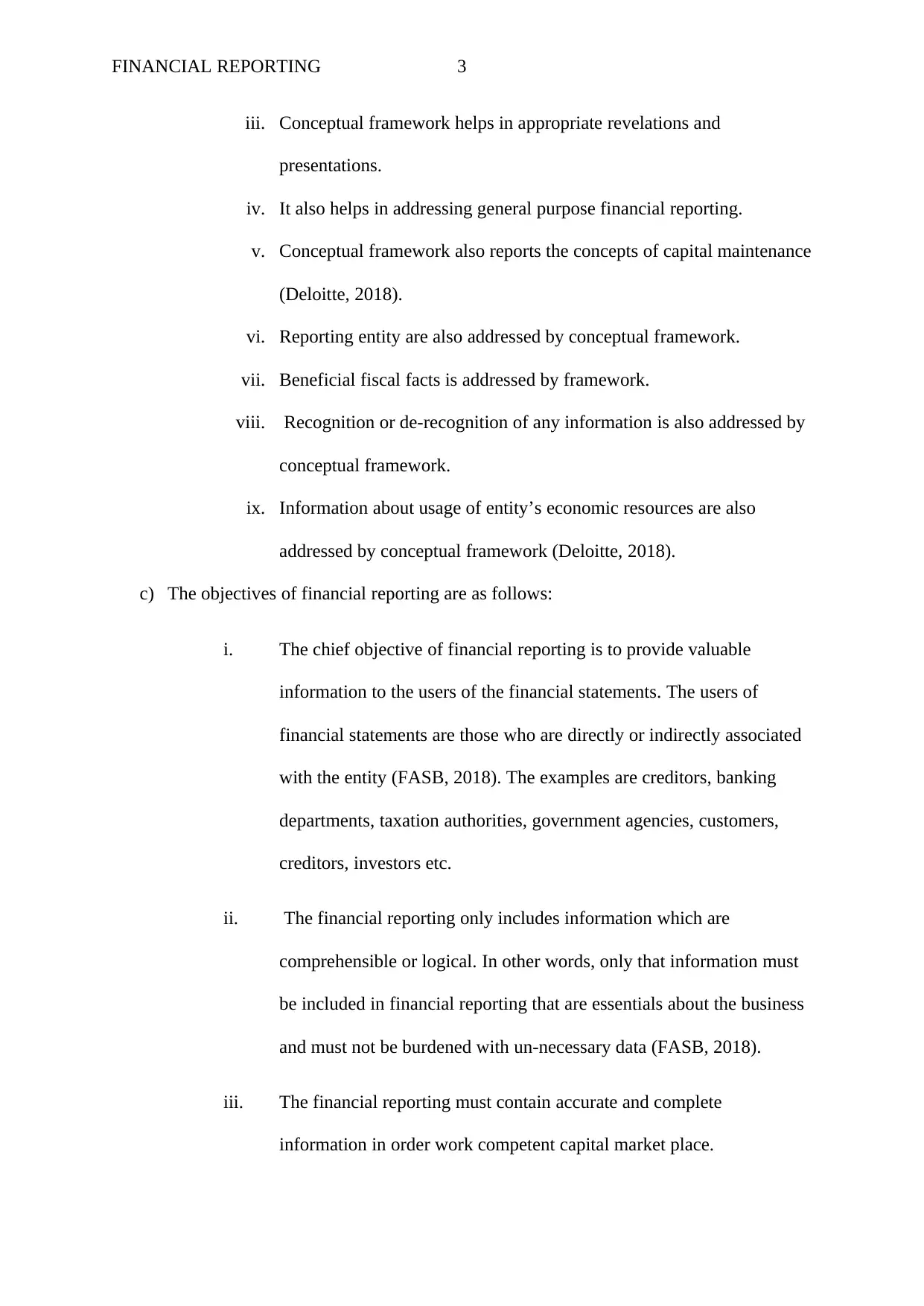
FINANCIAL REPORTING 3
iii. Conceptual framework helps in appropriate revelations and
presentations.
iv. It also helps in addressing general purpose financial reporting.
v. Conceptual framework also reports the concepts of capital maintenance
(Deloitte, 2018).
vi. Reporting entity are also addressed by conceptual framework.
vii. Beneficial fiscal facts is addressed by framework.
viii. Recognition or de-recognition of any information is also addressed by
conceptual framework.
ix. Information about usage of entity’s economic resources are also
addressed by conceptual framework (Deloitte, 2018).
c) The objectives of financial reporting are as follows:
i. The chief objective of financial reporting is to provide valuable
information to the users of the financial statements. The users of
financial statements are those who are directly or indirectly associated
with the entity (FASB, 2018). The examples are creditors, banking
departments, taxation authorities, government agencies, customers,
creditors, investors etc.
ii. The financial reporting only includes information which are
comprehensible or logical. In other words, only that information must
be included in financial reporting that are essentials about the business
and must not be burdened with un-necessary data (FASB, 2018).
iii. The financial reporting must contain accurate and complete
information in order work competent capital market place.
iii. Conceptual framework helps in appropriate revelations and
presentations.
iv. It also helps in addressing general purpose financial reporting.
v. Conceptual framework also reports the concepts of capital maintenance
(Deloitte, 2018).
vi. Reporting entity are also addressed by conceptual framework.
vii. Beneficial fiscal facts is addressed by framework.
viii. Recognition or de-recognition of any information is also addressed by
conceptual framework.
ix. Information about usage of entity’s economic resources are also
addressed by conceptual framework (Deloitte, 2018).
c) The objectives of financial reporting are as follows:
i. The chief objective of financial reporting is to provide valuable
information to the users of the financial statements. The users of
financial statements are those who are directly or indirectly associated
with the entity (FASB, 2018). The examples are creditors, banking
departments, taxation authorities, government agencies, customers,
creditors, investors etc.
ii. The financial reporting only includes information which are
comprehensible or logical. In other words, only that information must
be included in financial reporting that are essentials about the business
and must not be burdened with un-necessary data (FASB, 2018).
iii. The financial reporting must contain accurate and complete
information in order work competent capital market place.
Paraphrase This Document
Need a fresh take? Get an instant paraphrase of this document with our AI Paraphraser
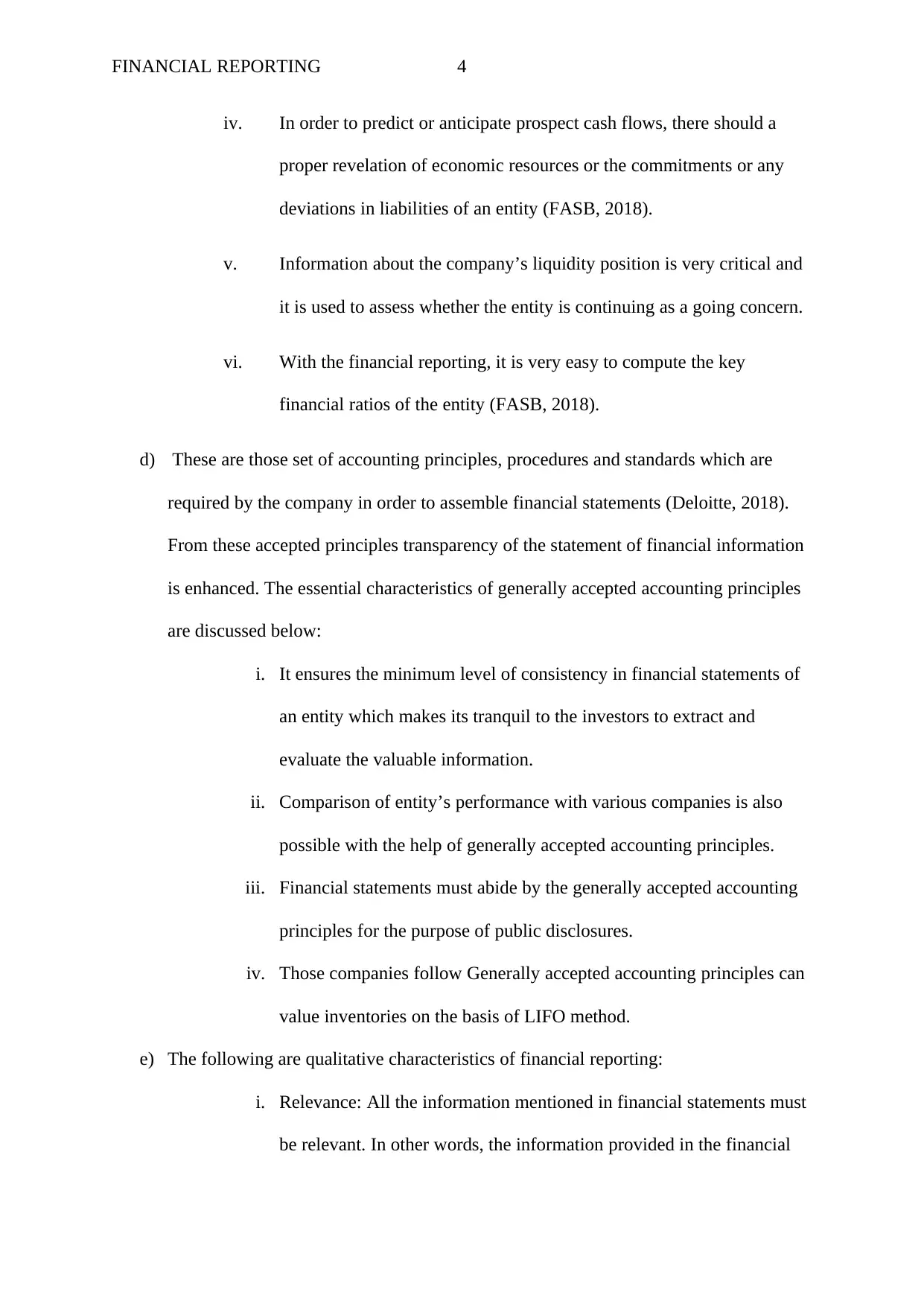
FINANCIAL REPORTING 4
iv. In order to predict or anticipate prospect cash flows, there should a
proper revelation of economic resources or the commitments or any
deviations in liabilities of an entity (FASB, 2018).
v. Information about the company’s liquidity position is very critical and
it is used to assess whether the entity is continuing as a going concern.
vi. With the financial reporting, it is very easy to compute the key
financial ratios of the entity (FASB, 2018).
d) These are those set of accounting principles, procedures and standards which are
required by the company in order to assemble financial statements (Deloitte, 2018).
From these accepted principles transparency of the statement of financial information
is enhanced. The essential characteristics of generally accepted accounting principles
are discussed below:
i. It ensures the minimum level of consistency in financial statements of
an entity which makes its tranquil to the investors to extract and
evaluate the valuable information.
ii. Comparison of entity’s performance with various companies is also
possible with the help of generally accepted accounting principles.
iii. Financial statements must abide by the generally accepted accounting
principles for the purpose of public disclosures.
iv. Those companies follow Generally accepted accounting principles can
value inventories on the basis of LIFO method.
e) The following are qualitative characteristics of financial reporting:
i. Relevance: All the information mentioned in financial statements must
be relevant. In other words, the information provided in the financial
iv. In order to predict or anticipate prospect cash flows, there should a
proper revelation of economic resources or the commitments or any
deviations in liabilities of an entity (FASB, 2018).
v. Information about the company’s liquidity position is very critical and
it is used to assess whether the entity is continuing as a going concern.
vi. With the financial reporting, it is very easy to compute the key
financial ratios of the entity (FASB, 2018).
d) These are those set of accounting principles, procedures and standards which are
required by the company in order to assemble financial statements (Deloitte, 2018).
From these accepted principles transparency of the statement of financial information
is enhanced. The essential characteristics of generally accepted accounting principles
are discussed below:
i. It ensures the minimum level of consistency in financial statements of
an entity which makes its tranquil to the investors to extract and
evaluate the valuable information.
ii. Comparison of entity’s performance with various companies is also
possible with the help of generally accepted accounting principles.
iii. Financial statements must abide by the generally accepted accounting
principles for the purpose of public disclosures.
iv. Those companies follow Generally accepted accounting principles can
value inventories on the basis of LIFO method.
e) The following are qualitative characteristics of financial reporting:
i. Relevance: All the information mentioned in financial statements must
be relevant. In other words, the information provided in the financial
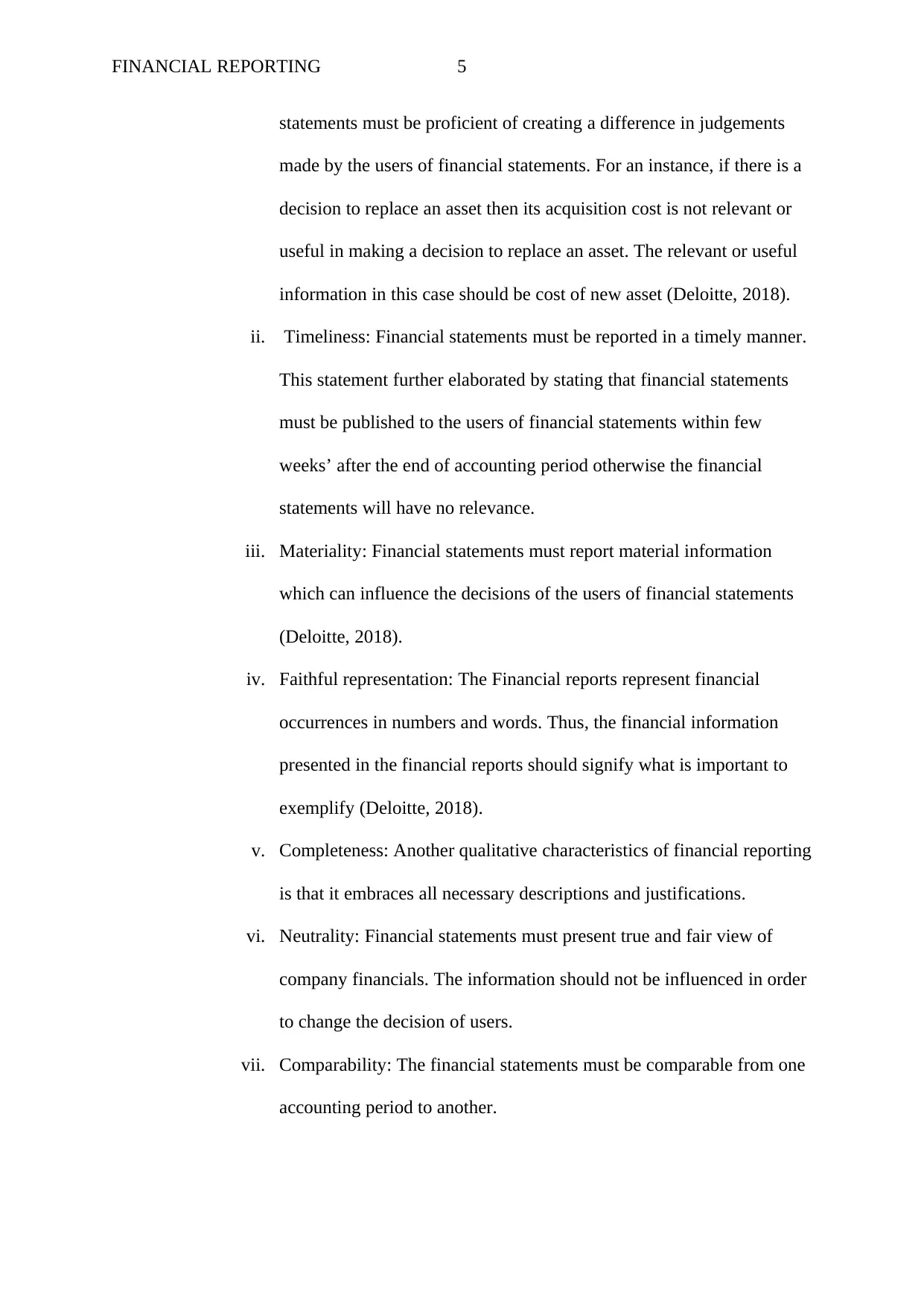
FINANCIAL REPORTING 5
statements must be proficient of creating a difference in judgements
made by the users of financial statements. For an instance, if there is a
decision to replace an asset then its acquisition cost is not relevant or
useful in making a decision to replace an asset. The relevant or useful
information in this case should be cost of new asset (Deloitte, 2018).
ii. Timeliness: Financial statements must be reported in a timely manner.
This statement further elaborated by stating that financial statements
must be published to the users of financial statements within few
weeks’ after the end of accounting period otherwise the financial
statements will have no relevance.
iii. Materiality: Financial statements must report material information
which can influence the decisions of the users of financial statements
(Deloitte, 2018).
iv. Faithful representation: The Financial reports represent financial
occurrences in numbers and words. Thus, the financial information
presented in the financial reports should signify what is important to
exemplify (Deloitte, 2018).
v. Completeness: Another qualitative characteristics of financial reporting
is that it embraces all necessary descriptions and justifications.
vi. Neutrality: Financial statements must present true and fair view of
company financials. The information should not be influenced in order
to change the decision of users.
vii. Comparability: The financial statements must be comparable from one
accounting period to another.
statements must be proficient of creating a difference in judgements
made by the users of financial statements. For an instance, if there is a
decision to replace an asset then its acquisition cost is not relevant or
useful in making a decision to replace an asset. The relevant or useful
information in this case should be cost of new asset (Deloitte, 2018).
ii. Timeliness: Financial statements must be reported in a timely manner.
This statement further elaborated by stating that financial statements
must be published to the users of financial statements within few
weeks’ after the end of accounting period otherwise the financial
statements will have no relevance.
iii. Materiality: Financial statements must report material information
which can influence the decisions of the users of financial statements
(Deloitte, 2018).
iv. Faithful representation: The Financial reports represent financial
occurrences in numbers and words. Thus, the financial information
presented in the financial reports should signify what is important to
exemplify (Deloitte, 2018).
v. Completeness: Another qualitative characteristics of financial reporting
is that it embraces all necessary descriptions and justifications.
vi. Neutrality: Financial statements must present true and fair view of
company financials. The information should not be influenced in order
to change the decision of users.
vii. Comparability: The financial statements must be comparable from one
accounting period to another.
⊘ This is a preview!⊘
Do you want full access?
Subscribe today to unlock all pages.

Trusted by 1+ million students worldwide
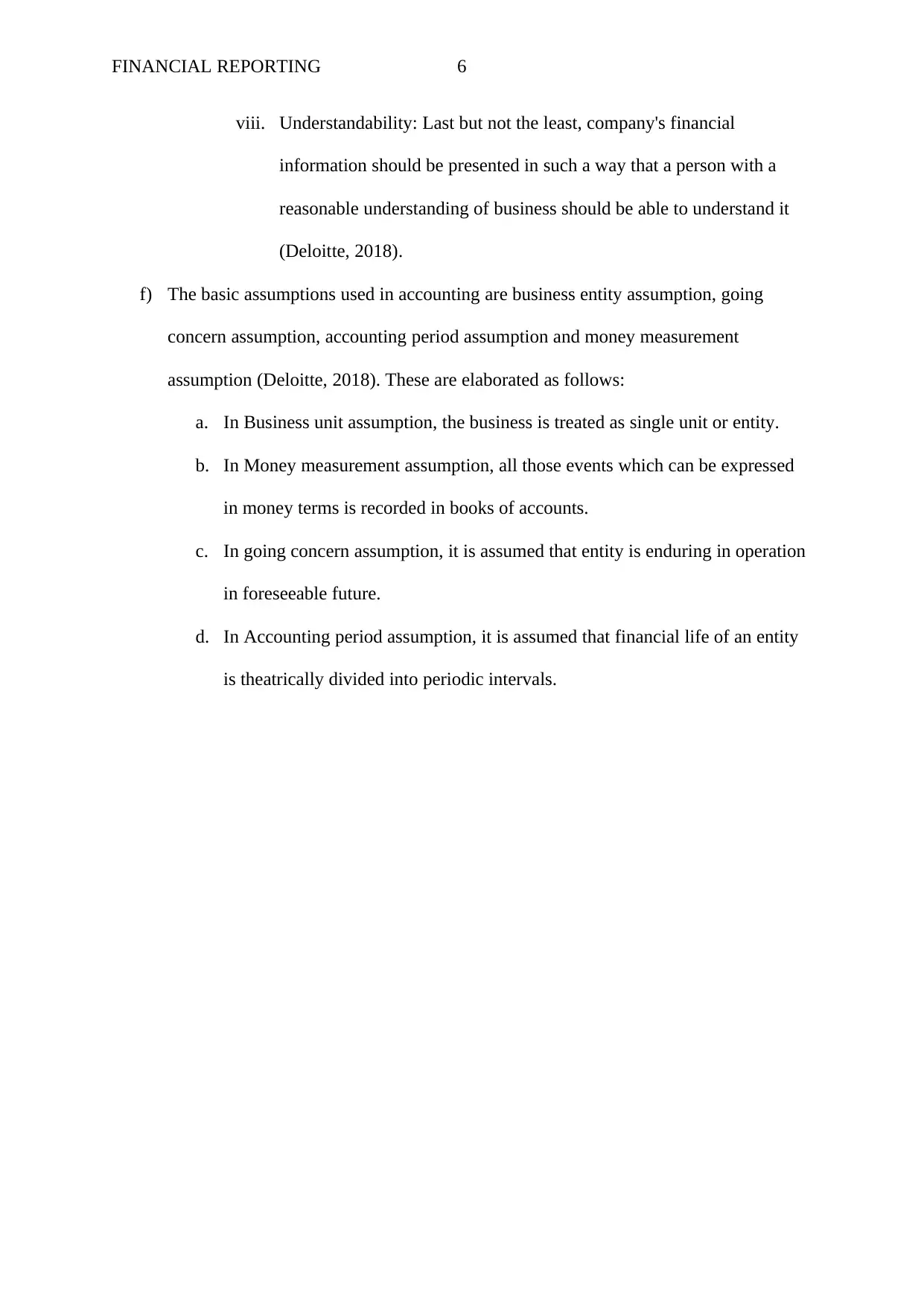
FINANCIAL REPORTING 6
viii. Understandability: Last but not the least, company's financial
information should be presented in such a way that a person with a
reasonable understanding of business should be able to understand it
(Deloitte, 2018).
f) The basic assumptions used in accounting are business entity assumption, going
concern assumption, accounting period assumption and money measurement
assumption (Deloitte, 2018). These are elaborated as follows:
a. In Business unit assumption, the business is treated as single unit or entity.
b. In Money measurement assumption, all those events which can be expressed
in money terms is recorded in books of accounts.
c. In going concern assumption, it is assumed that entity is enduring in operation
in foreseeable future.
d. In Accounting period assumption, it is assumed that financial life of an entity
is theatrically divided into periodic intervals.
viii. Understandability: Last but not the least, company's financial
information should be presented in such a way that a person with a
reasonable understanding of business should be able to understand it
(Deloitte, 2018).
f) The basic assumptions used in accounting are business entity assumption, going
concern assumption, accounting period assumption and money measurement
assumption (Deloitte, 2018). These are elaborated as follows:
a. In Business unit assumption, the business is treated as single unit or entity.
b. In Money measurement assumption, all those events which can be expressed
in money terms is recorded in books of accounts.
c. In going concern assumption, it is assumed that entity is enduring in operation
in foreseeable future.
d. In Accounting period assumption, it is assumed that financial life of an entity
is theatrically divided into periodic intervals.
Paraphrase This Document
Need a fresh take? Get an instant paraphrase of this document with our AI Paraphraser
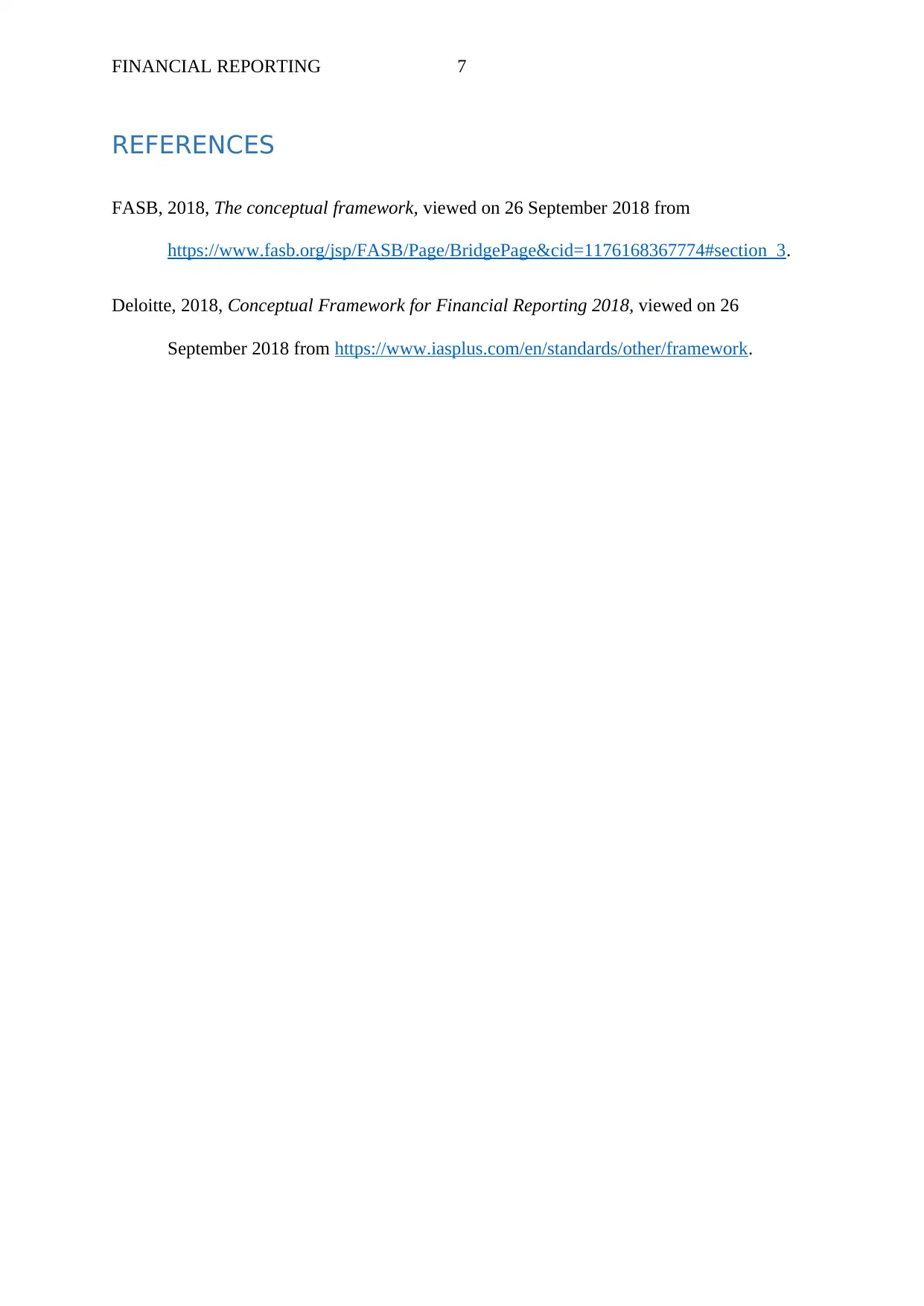
FINANCIAL REPORTING 7
REFERENCES
FASB, 2018, The conceptual framework, viewed on 26 September 2018 from
https://www.fasb.org/jsp/FASB/Page/BridgePage&cid=1176168367774#section_3.
Deloitte, 2018, Conceptual Framework for Financial Reporting 2018, viewed on 26
September 2018 from https://www.iasplus.com/en/standards/other/framework.
REFERENCES
FASB, 2018, The conceptual framework, viewed on 26 September 2018 from
https://www.fasb.org/jsp/FASB/Page/BridgePage&cid=1176168367774#section_3.
Deloitte, 2018, Conceptual Framework for Financial Reporting 2018, viewed on 26
September 2018 from https://www.iasplus.com/en/standards/other/framework.
1 out of 8
Related Documents
Your All-in-One AI-Powered Toolkit for Academic Success.
+13062052269
info@desklib.com
Available 24*7 on WhatsApp / Email
![[object Object]](/_next/static/media/star-bottom.7253800d.svg)
Unlock your academic potential
Copyright © 2020–2025 A2Z Services. All Rights Reserved. Developed and managed by ZUCOL.




